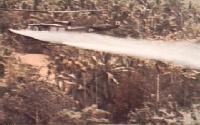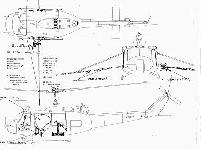|
Defoliation was meant to save lives by denying the enemy cover. But for some the 'cure'
was worse than the problem.
By Tony Spletstoser
The primary use of herbicides in Vietnam was to kill vegetation
and thereby deny cover to enemy forces. Heavily sprayed areas included
inland forests near the Demilitarized Zone and along the South Vietnamese
borders with Cambodia and Laos, and the mangrove forests in the Rung Sat
Special Zone along the river approaches to Saigon and in the Mekong Delta's
Ca Mau Peninsula.
The process was called defoliation, and it is nothing new. The American
agriculture industry has long been using chemicals to make the leaves fall
off cotton and soybean plants just before the mechanized picking machines
go into the fields. The chemical 2,4-D and its variants had been applied
to U.S. acreage by either crop duster-sprayer aircraft or ground spray
machines for years. But since the early '60s, the law has required
applicators, sprayer pilots and ground personnel to study and pass tests
before being allowed to handle or apply defoliants. They wear special
coverall flight suits, boots, face masks and gloves when handling the
chemicals, and are warned that the defoliant is a poison.
Such precautions, however, were not taken in South Vietnam between 1965
and 1971. Defoliants were handled carelessly and applied carelessly,
sprayed on both the enemy and noncombatants, and even our own men. To
compound the problem, our armed forces were told that the chemicals were
harmless to humans, despite early evidence to the contrary.
The 55-gallon drums of herbicide were identified by 4-inch-wide circular
bands of orange paint. Agent Orange (named for the chemical containers'
color banding) in theory was harmless to humans, and its persistence in
the soil was limited to only a few weeks. It was maintained that very high
dosages were necessary to produce any adverse effects on humans. However,
some Americans voiced considerable concern over the potential danger from
2,3,7,8-tetrachlorodibenzo-paradioxin, commonly known as Dioxin, an
impurity present in 2,4,5-T, the latter being the chemical compound Agent
Orange. Some 11,712,860 gallons of Agent Orange were sprayed on South
Vietnam between 1965 and 1971, and the defoliant was later alleged to have
caused long-lasting health problems.
Agent Blue, 100 percent sodium salt of cacodylic acid, is an arsenic
compound that was also sprayed over Vietnam. Although the organic compound
is not as toxic as the inorganic forms of arsenic, such as sodium arsenite,
it can be fatal to both animals and humans. A probable lethal oral dose
would be one ounce or more. There is no accurate way of gauging the effect
of the 2,161,169 gallons of Agent Blue sprayed on South Vietnam between
1965 and 1971 on drinking water and food stuffs used by the indigenous
people.
Air Force Fairchild UC-123 Providers rigged as spray planes applied most
of the defoliants in Vietnam. They had the A/A45Y-1 herbicide spraying
system installed, with 1,000-gallon pressure pumping tanks in the cargo
compartment. The spray material was routed to spray booms mounted on
hangers attached just forward of the aileron cutouts on each wing. The
Providers usually flew in a five-plane formation with fighter-bomber top
cover as well as helicopter gunships for close air support.
The defoliation program called Operation Ranch Hand lasted from January
1965 until February 1971. Ranch Hand aircraft were based at Tan Son Nhut,
Bien Hoa, Phan Rang, Nha Trang and Da Nang. There were occasions when,
pressed for time, aircraft were flown not rigged as spray planes but with
the forward side doors open and the rear ramp lowered. The flight crew
handlers simply took fire axes, chopped holes in the 55-gallon drums,
dumped them over on the deck near the rear ramp and let the vortexes suck
the material out of the aircraft, creating its own spray. These same
vortexes swirled the spray back inside the aircraft, completely soaking
the air crew. Even when the crews used spray equipment, it was impossible
not to be covered with the herbicide.
The lives of those UC-123 crewmen were in jeopardy at all times. In order
for the defoliant spray to be effective, the aircraft had to be flown low,
in a consistent flight track, and at airspeeds not much higher than 85
knots. This made for really good ground-fire target practice by the enemy.
After April 1969, all Ranch Hand operations used the jet-equipped UC-123K.
Some experimental high-speed runs were made at airspeeds of 180 knots, but
overall the high-speed approach did not work out. Normal spraying speed
was 130 knots at the lowest possible altitudes.
Those low flights could be dangerous business. On the morning of
April 7, 1969, for example, a formation of seven Ranch Hand aircraft had
planned to make three separate passes over their targets in the U Minh
forest. On the first pass, all but one were hit by machine-gun fire.
Two of the UC-123Ks each lost an engine and immediately headed to Bien Hoa.
The five remaining aircraft received ground fire on the second pass, the
last plane in the formation losing effective aileron control as bullets
penetrated its left wing and control surfaces. Other bullets struck the
leading edge of the right wing near the wing root. There, fuel and
electrical lines were cut, and a fire started that was fed by the booster
pump. The crew was forced to make an emergency landing at Ben Tre, and the
aircraft was damaged beyond repair.
While the UC-123 pilots were fairly well protected from the chemical by
their position up on the flight deck, the other crew members who had to
handle the spray equipment had no way to avoid exposure to Agent Orange.
No protective clothing or even special handling orders were issued.
 U.S.Army helicopters were also used to apply Agent Orange, and "Lucky" piloted
one of those choppers. In December 1970, "Lucky" was assigned to the 114th
Assault Helicopter Company at Vinh Long in the Mekong Delta.
At first, Lucky flew conventional troop lift insertions; then one day he
was selected for a different assignment, spraying defoliant.
U.S.Army helicopters were also used to apply Agent Orange, and "Lucky" piloted
one of those choppers. In December 1970, "Lucky" was assigned to the 114th
Assault Helicopter Company at Vinh Long in the Mekong Delta.
At first, Lucky flew conventional troop lift insertions; then one day he
was selected for a different assignment, spraying defoliant.

An Army team out of Saigon came in with the engineering and equipment to
convert Bell UH-1H Huey helicopters into sprayers for the Agent Orange
chemical.
By this time in 1971, the Ranch Hand operation had been pretty much shut down, but there still were
plenty of 55-gallon drums of Agent Orange around. Lucky's mission was to spray a site in the U Minh Forest.
As opposed to the five to seven UC-123Ks on spray flights, his flight consisted of only his one spray-rigged
helicopter, a command-and-control ship, and two Bell AG-1 Cobra gunships.
Lucky and his crew flew south to a landing zone located on the edge of the forest to load up with Agent
Orange. The spray rig in the helicopter consisted of the deck-mounted tank fixture supporting the spray
booms that extended out on each side to about three-quarters of the rotor-blade span. The spray tank of
approximately 200 gallons took up the entire cargo compartment between the back of the pilots' seats and
the transmission compartment bulkhead. The spray booms were served by a wind-driven pump that had a
24-inch-diameter, four-bladed propeller. Lucky's two enlisted crewmen had the job of manning the door
guns while in the air and refilling the tank when it was empty. The drill was to fly low over the trees
at 75 to 80 knots, which was about as fast as they could go.
The Huey managed to stay ahead of the spray mist except on the turns at the end of each pass or when the
wind changed direction. There was always a certain amount of spray mist drifting through the aircraft.
Before the day was done, all of the air crewmen were pretty well soaked. When the tank was empty, Lucky
would return to the landing zone, where the ground crew manhandled the 55-gallon drums over to the aircraft,
and his crew hand-pumped the defoliant material into the big tank on board. It took longer to refill than it
did to spray it out.
Lucky's part of this mission lasted two days. Now, some 25 years later, he isn't exactly sure how many
refills he flew a day, but he believes that he flew four sorties daily, which meant that he probably put out
a total of about 1,600 gallons of herbicide. After that, another air crew from the 114th took over. He never
had occasion to return to that area, but other pilots told him that after three or four weeks the sprayed
area started greening up as the plants put out new leaves. Everything was growing again.
At the time, Lucky had no idea of the catastrophe that flying the sprayer helicopter would make of his life.
A few years after he returned home, the psychological, emotional and physical problems caused by Agent Orange
began to surface. It took a while for Lucky to connect his problems with his two days of forest spraying. It
took even longer to get any satisfaction out of the Veterans Administration (VA). No one wanted to admit that
Agent Orange would cause any health problems. In 1976, Lucky had a vasectomy after learning that a friend who
had served with the 101st Airborne had had two children born with severe birth defects after his stint in
Vietnam.
After thousands of sheets of paperwork and medical tests, Lucky finally received a
100-percent service-connected medical disability. The VA, however, continued to insist that his disability
had nothing to do with Agent Orange.
In 1990 Lucky remarried, and his new wife has indicated that she would like to have children. On one of his
check-up visits to the VA hospital, he asked his doctor if it was possible to reverse a vasectomy. The VA
doctor told Lucky that there would be a 50-50 chance of success, but that he would advise against it because
of Lucky's exposure to Agent Orange.
| 
